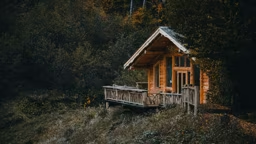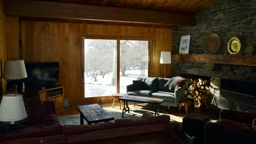Whether you want a roaring campfire once a month, or a steady supply of fuel to get you through a wintry fortnight, you’ll need dry wood. Unfortunately, not everybody has the luxury of a woodshed or covered porch at the cabin. But don’t worry: You can have a supply of moderately dry wood at the ready. Just follow some simple steps to get that wood down to the magic seasoned mark of 20% moisture or less.
Elevate the stack. Ground moisture can quickly rot out the bottom rows of firewood. Use pallets to lift the bottom row 6-plus inches off the ground.
Take advantage of standing timber. Wood dries best when it’s stacked several feet high, promoting air circulation. If you don’t want to drive support posts into the ground, use large standing trees as end supports. Also, leave several inches of airspace between rows.
Stack it right the first time. You can minimize water reentry and maximize airflow by stacking the wood bark-side-up using a crosshatch pattern: two pieces one way, topped with two pieces perpendicular to the first pair.
Smaller diameter wood typically dries more quickly. However, if the diameter is under about 10 inches, split the wood only once. This will give you two semicircles; place the rounded, bark-covered side to the sky (place the wood bark-side down if you’re stacking in a covered woodshed). The exterior will help shed water, while the exposed wood underneath will still breathe, expelling moisture into the air. This approach also works with debarked wood, since the rounded surface limits water penetration. Having two equal pieces also helps you stack your crosshatched rows evenly.
To tarp or not to tarp? Tarps can be unsightly (and noisy, if not properly secured against the wind). They are, however, a cheap, effective method to keep rain and snow off your wood.
Don’t completely cover a wood pile or stack with a tarp, as the moisture from the ground and firewood itself will not be able to escape, essentially steaming your firewood. Place the tarp so it covers only the top few rows of firewood. If you can stack your wood between posts or trees, run a length of rope or cord between the posts/trees above the stack. Drape the middle of the tarp over the rope and stake down each side, leaving a gap between the tarp and the ground. This “firewood tent” effectively sheds rain and snow while allowing air movement. For more aesthetic appearances, consider clear plastic sheeting or a camo tarp, which will blend better into the surroundings.
Elevate the stack. Ground moisture can quickly rot out the bottom rows of firewood. Use pallets to lift the bottom row 6-plus inches off the ground.
Take advantage of standing timber. Wood dries best when it’s stacked several feet high, promoting air circulation. If you don’t want to drive support posts into the ground, use large standing trees as end supports. Also, leave several inches of airspace between rows.
Stack it right the first time. You can minimize water reentry and maximize airflow by stacking the wood bark-side-up using a crosshatch pattern: two pieces one way, topped with two pieces perpendicular to the first pair.
Smaller diameter wood typically dries more quickly. However, if the diameter is under about 10 inches, split the wood only once. This will give you two semicircles; place the rounded, bark-covered side to the sky (place the wood bark-side down if you’re stacking in a covered woodshed). The exterior will help shed water, while the exposed wood underneath will still breathe, expelling moisture into the air. This approach also works with debarked wood, since the rounded surface limits water penetration. Having two equal pieces also helps you stack your crosshatched rows evenly.
To tarp or not to tarp? Tarps can be unsightly (and noisy, if not properly secured against the wind). They are, however, a cheap, effective method to keep rain and snow off your wood.
Don’t completely cover a wood pile or stack with a tarp, as the moisture from the ground and firewood itself will not be able to escape, essentially steaming your firewood. Place the tarp so it covers only the top few rows of firewood. If you can stack your wood between posts or trees, run a length of rope or cord between the posts/trees above the stack. Drape the middle of the tarp over the rope and stake down each side, leaving a gap between the tarp and the ground. This “firewood tent” effectively sheds rain and snow while allowing air movement. For more aesthetic appearances, consider clear plastic sheeting or a camo tarp, which will blend better into the surroundings.
AVOID EAVES
Many people take advantage of overhanging cabin eaves to keep their firewood dry. However, stacking wood next to your cabin can have significant consequences. A pile of seasoned wood next to your cabin is a fire hazard, especially if there is tall grass or brush nearby, and your cabin is in an area where wildfires might occur. Also, stacking wood directly against the cabin can trap moisture between the wood and the cabin, which can cause mildew formation, discoloration, and even rot on the siding.
SAVE YOUR HEARING
Wear hearing protection during exposure to loud levels of noise. This includes using the chain saw or other power tools, mowing or leaf blowing.
Many people take advantage of overhanging cabin eaves to keep their firewood dry. However, stacking wood next to your cabin can have significant consequences. A pile of seasoned wood next to your cabin is a fire hazard, especially if there is tall grass or brush nearby, and your cabin is in an area where wildfires might occur. Also, stacking wood directly against the cabin can trap moisture between the wood and the cabin, which can cause mildew formation, discoloration, and even rot on the siding.
SAVE YOUR HEARING
Wear hearing protection during exposure to loud levels of noise. This includes using the chain saw or other power tools, mowing or leaf blowing.

 Thinkstock.com
Thinkstock.com 









